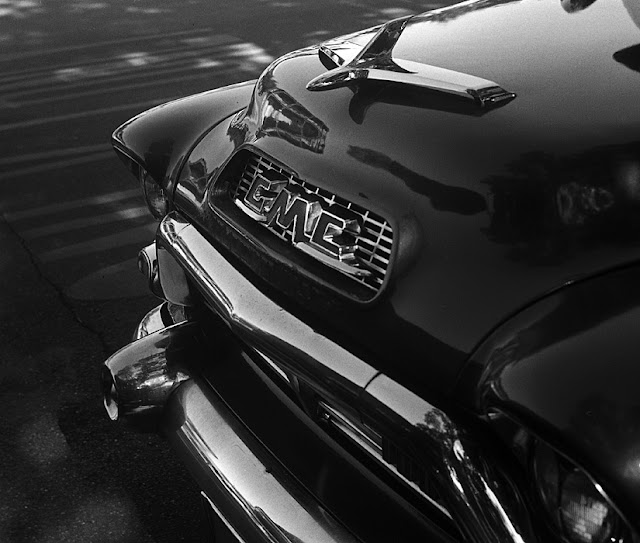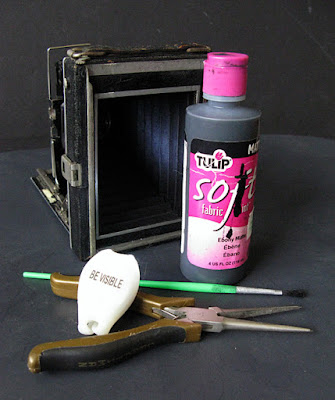I decided a good first step in working more with my collection of plate cameras would be to examine each of them thoroughly and make whatever adjustments and repairs were needed to get the best performance from them.
 |
| The Bentzin Primar at the Velvet Cafe - (picture from the Olympus mju on Fuji 200 film) |
I found a few overlooked pinholes in all five cameras. To my surprise, when I fully extended the bellows of my Benzin Primar I found a torn front corner causing a hole that I could poke a finger into. I removed the lens and shutter assembly to free up the front end of the bellows, and a little super glue closed up the hole nicely. I loaded a roll of Tri-X in the camera and took it out for a test drive.
 |
| On a bright Spring morning Aspen shadows dance at my window. |
Back to the Plaza Vieja for the little Friday car show.
 |
| jimmy |
 |
| BelAir (Tessar lens - f11 at 1/250) |
 |
| 100% enlargement at 1200dpi |
I've gotten good results in the past with the combination of Tri-X film and Rodinal developer, but I was not real pleased with it on this occasion. I'm willing to chalk this up to operator confusion, but I still have a complaint against Kodak. The frame counting numerals have been made so dim on the paper backing that it is just about impossible to see them through the ruby window of a folding camera. That would not be a problem with a camera like the YashiaMat which has auto-frame-spacing, but I'm going to need to find some other option for any of my folders.

This is my essential tool set for getting my folding cameras up to speed. Tiny pinholes in the bellows can be very difficult to track down. I have tried several lighting methods in this quest, but the best so far has been a very small flashlight with exposed LED bulbs. The little "BE VISIBLE" bike light lets me press the bulbs right into the bellows creases. Once found, the pinholes are painted over with Tulip ebony fabric paint. The fabric paint stays a little tacky even after drying, so it is best applied judiciously. I have tried other products, but the Tulip paint stores better than anything else, and I've had this bottle for years. The needle nose pliers with the tips filed down are especially useful for loosening the retaining ring that couples the bellow to the shutter and lens assembly while the bellows is partially extended. If the job is attempted with the bellows fully collapsed there is a danger of damaging the fabric with the rotating tool.
 |
| nice doggie |







7 comments:
Really very pleasing quality to that lens. It especially shines on those vintage car shots.
Yes. The Tessar design is over a century old now, but it is still hard to beat for sharpness. At the time my Bentzin Primar was made the max aperture for the Tessar was f4.5. After WWII lens coating improved performance and a max aperture of 2.8 was achieved. Zeiss owned the patent and the name, but other companies brought out lenses with very similar designs like the Xenar and the Voigtlander Skopar.
The photo of the GMC snout is just stellar. The rich tones stopped me in my tracks.
Nice shots Mike. I can't really pick a favorite. I have had good luck also with Acros and Rodinal, but my favorite developer for medium or large format Acros is caffenol-cl with 60 - 70 minutes stand development. Do you have to modify the plate holders to hold the film flat?
Acros seems to do well in a variety of developers. I was looking back through some of my past work with Acros and was surprised to find I had gotten nice pictures with hc-110 and D-76.
I have only used my plate cameras with the Rada and Rollex accessory roll film adapters. Both of those do a good job of holding the film flat. The sheet film holders I have look like they would not present a problem with flatness either, though I have no experience in using them. All my plate cameras are 6.5 x 9 format and I don't think you can buy that size in sheet film any longer. I have considered acquiring a 9x12 camera so I could shoot still-available 9x12 sheet film, but that would mean getting set up for processing and that may be a step too far for me.
P.S.
James, I got to thinking about your comment and realized that in the text of my post I had written "Acros" when I meant to say Tri-X, so I crossed that out and wrote Tri-X. I've never had anything but good results from Acros and Rodinal. I'm giving up on Tri-X at this point because of the backing paper problems and trying some of the chaper 400-speed stuff like Arista Edu Ultra 400.
Ah. Well that makes more sense. I have surprisingly little experience with Tri-x. I always thought it was a little over-priced. Also, I tend to use older cameras that were designed with 100 speed film in mind. So I shoot in the sunlight here in San Diego. Keep up the good work with those plate cameras. You have got me watching the auction sites for a bargain. I was thinking that shooting paper in the plate holders might work if you don't mind the caveats of paper negs.
Post a Comment